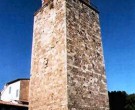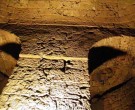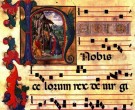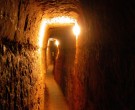> Home > What to visit > Museums

Museo della Cattedrale e Cunicoli Etruschi Chiusi
MUSEUMS
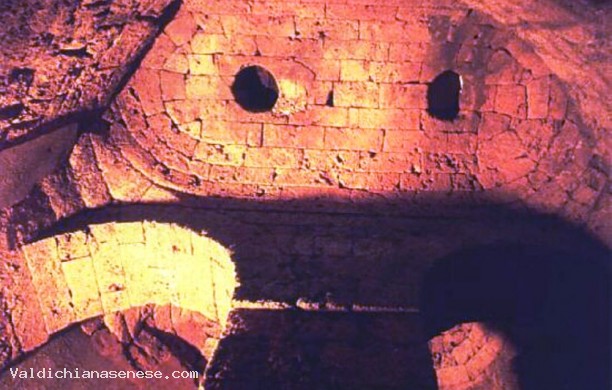
PHONE NUMBERS AND TIMES
Museo della Cattedrale e Cunicoli Etruschi
piazza del duomo 7 Chiusi
Telephone 0578-226490
Business card (vCard)
ORARI DI APERTURA E VISITA:
OPENING HOURS From June, 1st to October 15th: from 9.30a.m. to 12.45p.m. and from 4.30p.m. to 7p.m. From October 16th to May 31st: from 9.30a.m. to 12.45p.m.
The Museum of the Cathedral of Chiusi follows an extremely variable path, that allows one to visit parts of the palace, the Episcopal garden and vegetable garden , the Etruscan tunnels, the bell tower and outside the inhabited center , the Catacombs of Saint Mustiola and Saint Catherine, the only Christian catacombs located in Tuscany.
The first part of the Museum , dated 1932, was commissioned by Bishop Giuseppe Conti (in charge at the time ) to preserve the chorale volumes of the Abbey of Monte Oliveto Maggiore. In 1984 a new wing of the museum was created. On May 30th, 1992, the new extension ,that includes four rooms on the first floor of the building that connect themselves to the hall of the Chorals , has been opened.
The Episcopal garden and vegetable garden have been part of the museum route from the beginning, whereas the archeological itinerary with the Etruscan tunnels, through which it’s possible to reach the Roman cistern and the bell tower above it , has been opened only in 1995. The first exhibiting section of the museum is located on the ground floor, close to the Cathedral of Saint Secondiano: epigraphical moulds, lamps, ceramics and glass fragments, found in the catacombs of Saint Mustiola and Saint Catherine are exhibited therein. A few marble tables and fragments from an ancient ciborium come from the cathedral of Saint Mustiola ( not existent anymore).
A mosaic pavement , probably part of a building , dated between the end of the IVth and beginning of the Vth century, has come to light during the diggings of the presbytery area of Saint Secondiano. In the first room, there are also exhibited materials from the Imperial Roman Age: among them a small marble cinerary urn from the Augustan period and part of a large marble sarcophagus with scenes of battles against barbarians, dated between the end of the second century and the beginning of the third century A.D. Climbing the stairs, on the right side ,on an upper level, there are two Angels, that support two candle holders, that come from the chapel of the Holy Sacrament of the Cathedral.
The inscription on the back, reminds us that they were carved by Tommaso Pagliazzi in 1789. The Grand Duke Pietro Leopoldo, donated in 1787, a rich altar frontal for the main altar of the Cathedral. It’s made of crimson silk velvet, decorated by gold thread lace and with a central coeval embossed silver medallion , representing the Immaculate Virgin. The two lateral ovals, that represent Bishop Saints ,have been added during the late 1800s. In the adjacent room, are gathered silver objects, vases, canonicals, sacred wardrobes, most of which coming from the Cathedral of Saint Secondiano : considerable are two reliquary caskets made of ivory and wood, dated XVth century, and made by the Bottega of the Embriachi, active in Venice and in Lombardia.
The first casket, that is bordered by frames with geometric inlays made of different types of wood, lacks any type of decorations on the sides and it’s enriched by angular ivory towers . The other casket belongs to a richer production, and the ivory plates represent biblical scenes from Susanna’s stories. .Both pieces, of unknown origin, arrived in the Cathedral between 1607 and 1620. The room also hosts a bust reliquary, made in polychromous inlaid wood , dated beginning 1600s, and representing Ireneo, the Deacon Saint , imprisoned for having buried the martyr Felix in Sutri, and comforted while in prison by the noble lady Mustiola, patron of the diocese of Chiusi .
The showcases enclose several wardrobes, materials and sacred vases realized between the XVth and XIXth century: an alms plate, dated 1400, made in Germany and originally located in the parish of Saint Peter in Macciano is very interesting. The temptation of Adam and Eve is represented embossed in the center. It’s the most popular iconography represented on such plates. A similar plate is found in the church of Saint Mary of the Stairs in Ragusa. A chasuble, dated 1600, that displays on the embroidery of the cope, images of the Assumption of the Virgin, a cherub’s head and the monogram of Saint Bernard, in a style related to Florentine manufacturing dated early 1500s,and also a reliquary of the Holy Cross, with a silver lamina puncheon on the shaft , realized in the shop of Sienese silver makers Bonechi are quite interesting. An ivory Cross with a marble pedestal and a series of brass candle holders, originally from Monte Oliveto Maggiore, were donated to the Cathedral in 1800.
From here, one proceeds up to the narrow gallery , in which are exhibited twenty one ancient manuscripts from Monte Oliveto Maggiore, Abbey that was part of the diocese of Pienza , led by Bishop Giuseppe Pannilini, who was also bishop of Chiusi. The prelate, that had become the owner of the precious volumes, following the Napoleonic suppressions, donated them to the Cathedral of Saint Secondiano in 1810. The chorales were stolen at the end of 1987, but they were fortunately found after a month and they were placed again in their original location on June 25th, 1988. The chorales were commissioned , in 1456, by Francesco della Righiera, Abbot General of the Olivetan Order (found by Bernardo Tolomei , ordained in 1344, while its founder was still alive), in order to endow the monastery with a complete chorales cycle, composed by thirteen antiphonaries, a psaltery, four graduals and a kirial gradual. The copying of the volumes, countersigned by initial letters, are attributed to the monk from Monte Oliveto, Alessandro da Sesto Milanese and his shop. Alessandro was a famous calligraphist, but also a pen miniaturist, that is , he was the author of the filigreed initial letter , decorated with red or blue ink, where the parchment peeks through the empty spaces .Other initial letters are attributed to Friar Bartolomeo from Ferrara and to another fellow brother, Ambrogio from Milano. Also Friar Bartolomeo di Boniforte from Vimercate ,a calligraphist and a filigreed artist, contributed to the decoration of the chorales volumes. A few of the most famous artists of the time were called to realize the “brush” miniatures up to 1490. Among these , stand out the Sienese Sano di Pietro, that worked in the monastery from 1459 to 1463 and the Florentine Bartolomeo d’Antonio Varnucci, whose presence is not recorded but it can only be presumed analyzing the painting style. The most conspicuous amount of work, numerically speaking , is attributed to Venturino Mercati, a miniaturist educated in Lombardia, and still attached to a style coming from a Flemish – Burgundian and Ferrara tradition . The other Masters that have worked on the chorales volumes of Monte Oliveto were less attached to the late Gothic culture and they seemed more projected towards the Renaissance: Liberale da Verona ( seven mini and several leafy initials are attributed to him); he worked on them around 1466; Gerolamo da Cremona realized only one minium in 1472, while one presumes that the participation of Francesco di Giorgio Martini is limited to his shop. The gallery of the chorales takes us to the rooms ,that were opened in 1992 in the Episcopal Palace, to host works from the diocese of Chiusi: the origin of the incomplete table representing a Madonna with Child seated on a throne with Saint Giacomo and Saint Andrea on each side, attributed to the Sienese painter Girolamo di Benvenuto is unknown; whereas a Madonna with Child seated on a throne and attributed to the same artist comes from the church of Saint Francis in Cetona. On the major altar of the same church there was a small canvas representing a Madonna with Child, attributed to Sano di Pietro. The painting is dated between 1455 and 1460: considering its small dimensions, it’s difficult to hypothesize its original use, but one could presume that it was destined to private devotional purposes and that it was later placed in a silver frame ,dated 1600 and manufactured in a Roman goldsmith shop. In 1806, a pedestal was added to the frame. A table representing a Madonna with Saint Mustiola and Saint Felice (or Ireneo): already attributed to the shop of Sodoma, it’s been lately attributed to the Sienese painter Marco Bigio, character of vague biographical aspects. The subject of the painting induces us to presume that it comes from the Cathedral of Saint Mustiola and it reminds us of the partially legendary Passion of the Saint, characterized by the flagellum, in this case made of a club from which come out three ropes ending with three lead balls, with which the young noble lady was whipped to death. The other saint represented is either identified as the martyr Felix, buried by Ireneo, or as the same Ireneo. It’s definitely Saint Felix , who is depicted on another canvas, in front of an idealized view of Chiusi. The touching sculpture of Christ Crucified , made of polychromous wood, dated between the XIVth and XVth century, comes from the Parish of Macciano: it was used both as a cross and also for the exposure during the Holy Week. In the middle of the room are gathered , in a show case, important goldsmith’s pieces: an altar cross , dated early 1400, that shows Christ on the recto and the Virgin and Saint John, Magdalene and the pelican on the terminal cusped spaces ; the versus shows the Blessing Christ and the Evangelists ( the inferior part is missing). A “stauroteca”, that is one of those reliquaries destined to preserve the fragments of the “Real Cross”, and that followed its shape, was originally preserved in the Cathedral of the Holy Trinity in Cetona. On an inscription appears the year 1436. Lately it’s been suggested , since it bears close analogy to the Cross in the Museum of the diocese of Pienza, that the artist is probably Goro di Ser Neroccio. On the versus there are simple stones and miniatures added during the XVIIth century. A gilded copper tabernacle door had already been used for the marble niche on the altar of the Cathedral of Saint Lawrence in Sarteano, created in 1514 by Lorenzo di Mariano, nicknamed Marrina. The project of the tabernacle door, later terminated by a Sienese goldsmith , can easily be attributed to Marrina. On the inferior part, there’s an inscription with the date of the execution of the tabernacle and of the person that commissioned it; the canon of the cathedral of Siena, Francesco Pilli, that wanted the crescent moon repeated on the elegant work, in reference to the code of arms of the Piccolomini Todeschini family, that protected him. The Grievous Mother preserved in the next room, comes from the Cathedral: the Virgin appears next to a marble parapet with symbols of the Passion . It’s a copy dated 1600, limited to the figure of the Madonna, inspired by the Christ in the sepulchre with the Virgin, dated 1580, signed by Alessandro Allori , presently deposited in the Museum of Arezzo. Many analogous copies are known, testifying in this way the great fortune of such a subject that through the suffering glance of the Madonna and the emphasis on the most devotional elements , expresses the pathetic aspect of a certain reformed type of painting. The table representing Christ carrying the cross, work of a Florentine painter of the middle of the 1500, makes reference to the same religious climate. The canvas representing the Sacred Family with Saint Giovannino and Saint Catherine is attributed to a Sienese artist, that operated between the XVIth and XVIIth century, and indicated by critics as being Francesco di Vincenzo . The Virgin is represented in an intimate and familiar way, seated on a small chair; she’s teaching the Child to read. He wears a charming red garment, and small sandals ; He’s protected by a coral necklace and coral bracelets and He’s being distracted by a gesture of Saint Giovannino. In the background appears Saint Joseph, whereas on the side there’s Saint Catherine absorbed in prayer. The canvas of the Madonna in Glory with Saint Francis is attributed to Vincenzo Rustici; a Saint Ireneo is attributed (not 100%) to Sebastiano Folli and the Mystic Nuptials of Saint Catherine to an Emilian painter , who operated in the second half of the 1500s. In a central showcase are exhibited silver pieces and a closet preserves the garments used for the Pontificate by the bishop Carlo Bandini, bishop of Chiusi since 1941. The bishop died in 1970. In the third room there are several canvases: a beautiful octagonal painting representing Christ blessing bread, attributed to the Florentine Matteo Rosselli, dated early 1600, the Allegory of the Passion of Jesus, attributed to an artist, maybe Sienese, dated late 1600; a Christ Flagellated attributed to a Tuscan painter, and two landscapes, dated 1700. A velvet chasuble , made in Venice, comes from the parish of Saint Paul Converso in Celle sul Rigo. The fourth room, reachable from the first one, exhibits some goldsmith pieces in a showcase, among which two silver lamps in triple suspension , dated 1714, and originally located in the church of Saint Michael in Cetona. A portrait , that shows on a letter the year 1645 and the name Nicola Paganucci, has been attributed to an artist close to Ilario Casolani: the severe portrait, maybe an astronomy scholar, considering the armillary sphere on the table , is in contrast with the pretty girl that wears a charming apron and coral bracelets. The canvas representing Saint John in the Desert is attributed to a XVIIth century Sienese artist . An Annunciation, dated 1646 with the initials F.G. comes from the same place. From here, one goes back to the ground floor and exits in the Episcopal vegetable garden, where it’s possible to look down into a 20 meter deep well. Then one proceeds to the terrace and descends an iron staircase, from where are visible the results of the diggings executed in1980, that have brought to light the remains of an ancient Roman perimeter wall, part of a Hellenistic wall and the ruins of a Medieval tower. The museum tour proceeds through a tunnel, made accessible by huge restructuring works, that terminated in 1995. The section of the tunnel, freed from debris accumulated throughout the centuries , penetrates 10 meters deep for about 120 meters. It represents only a minimum part of the galleries dug in the hill, made by pliocenic sand ( tuff) and by a conglomerate called “tischio” . They are connected with the urban settlement through wells and cisterns. The tunnels date back to the IVth century B.C. and they were probably used for the disposal, drainage and urban water supply ; but popular legend has transformed them in the mythical “ Labyrinth of Porsenna” , that according to legend , conceals in its center the mysterious tomb of Porsenna, tale narrated by Plinius , the Elder . Following the ramified path, one finally reaches, under the Cathedral square almost in axle with the bell tower, a magnificent Etruscan- Roman cistern with the walls dug out of sandstone rock. It dates back to the Ist century B.C. and it has a circular plan, with a diameter of over six meters and a height of about eight meters. On a central travertine pillar start out two arcades that divide the upper part in two barrel vaults. The travertine blocks are united with great precision without the help of lime. The walls, in the upper part, still show traces of a particular plaster called “cocciopesto”, that probably made them watertight. Originally, the cistern was used as a water reserve, it was also probably used in case of fire. The pre existing Etruscan tunnels were perhaps used to let water flow in order to purify it . Since 1954, it’s been possible to visit the cistern, entering through the main square, whereas in 1995, the tunnels connection with the cistern has been reopened. The tour continues by proceeding towards the XIIth century bell tower, that originally was a defensive structure made of squared travertine pieces. Later on , in 1585, it was converted in the Cathedral’s bell tower with the addition of the bell cell, made of bricks. A modern staircase, built in 1994,with 142 steps, allows the visitor to reach the top terrace, from where one can admire a fantastic view that extends up to Montepulciano, Lake Trasimeno, the Amiata area and the Valdichiana.
STAY NEARBY
LA BADIOLA
CHIUSI
Large farmhouse immersed in the romantic setting of the Sienese countryside provides hospi...LA FATTORIA
CHIUSI
The Fattoria is an old farmhouse of the 18th century situated in a particuraly quiet place...DEL SOLE
CHIUSI
L 'hotel Del Sole è un piccolo albergo immerso nel verde delle colline toscane, sit...DINING & ENTERTAINMENT NEARBY
Teatro Mascagni
CHIUSI
A dare i natali al teatro di Chiusi è l'Accademia dei Filateti, fondata nel 1818 e ...Clev Village Multisala
CHIUSI
...Teatro degli Arrischianti
SARTEANO
Il Teatro Comunale degli Arrischianti di Sarteano è all'interno del Palazzo Comuna...



